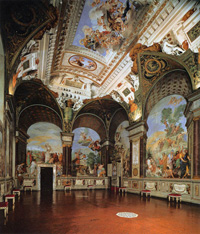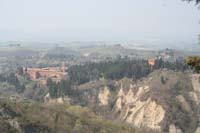| |
|
| |
|
|
|
|
|
|
| |
 |
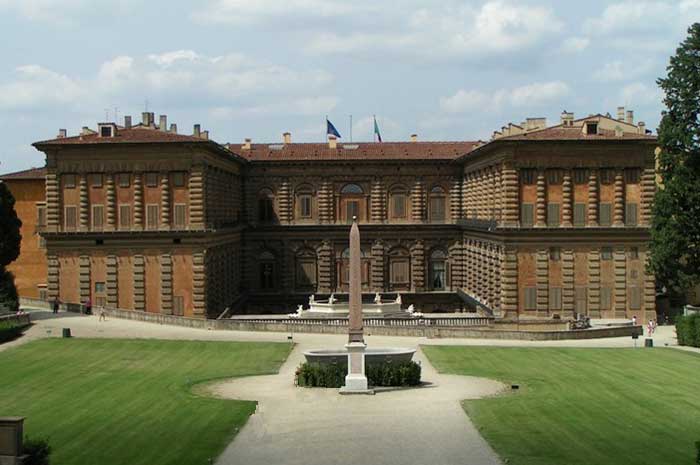 |
|
 |
 |
Palazzo Pitti, seen from Boboli gardens, Florence
|
|
 |
 |
| |
|
|
|
| |
|
Tuscany Travel Guide | Art in Florence The Palazzo Pitti
|
|
|
|
| |
|
Pitti Palace or Palazzo Pitti is the most monumental of the Renaissance Florentine palaces. Palazzo Pitti, opening on to the Boboli gardens, was a more prestigious and appropriate alternative for the Medici than their residence in Palazzo Vecchio, still the symbol of Florence's Republican past. Cosimo and Eleonora decided to turn it into a princely palace and charged Bartolomeo Ammannati with completing and, above all, enlarging the building.
|
|
|
|
| |
|
|
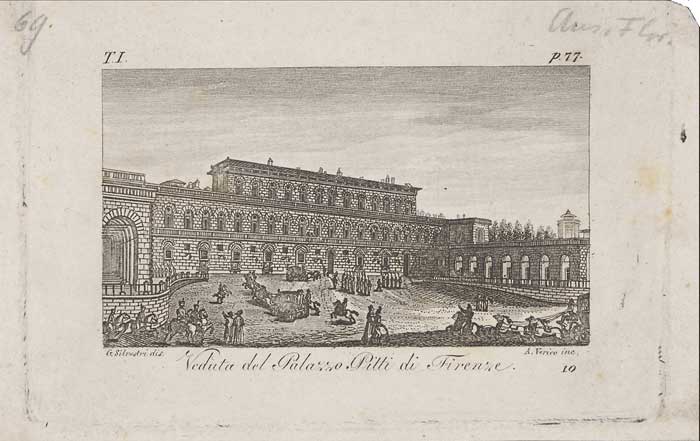 |
Guglielmo Silvestri: View of the Palazzo Pitti, copper engraving, 8.2 x 13.1 cm,
in Vedute pittoresche della Toscana, 2 volumes, Florence 1827, Vol. 1, p. 77 [ 1]
|
Luca Pitti, Florentine merchant and banker, had his family palace built on the edge of the city centre south of the River Arno from about 1454 onwards. In 1549, the Medici family bought it and had it extended to create a magnificent residence for the rulers. However, the building in its current form was only completed in the 19th century: Between 1764 and 1839, the new Grand Dukes of Tuscany from the House of Habsburg-Lorraine built the two wings either side of the forecourt, which gave the Piazza de' Pitti its characteristic appearance. It is not easy to visually reproduce this monumental building. The impact of the 36-metre high front, in a uniform repetitive design, is increased by the upwards slope of the forecourt and is much easier to capture using a slightly diagonal perspective rather than a direct head-on one. Antonio Terreni and Guglielmo Silvestri chose this kind of perspective for their portrayal of the building. Giuseppe Gherardi followed this example as well. He also included the rows of houses opposite in his view and thus placed the palace in its urban context. Behind the palazzo, the view opens out over the Boboli gardens behind the Mannerist inner courtyard designed by Bartolomeo Ammanati. The gardens are not only scenographically connected with the palace, but also provide to this day some of the most beautiful views of the city. One of these is the view by Guglielmo Silvestri.[1]
|
| When the rich Florentine merchant Luca Pitti died, the palace on the other side of the Arno was still unfinished. It was never proved that Brunelleschi was the author of this Palace. What is known for sure, though, is that the building was much smaller than the present one. At that time, Florence was governed by Pitti's implacable adversaries, the Medici, and destiny was to have it that the building end up in their hands when the rich wife of Cosimo 1 bought it with the park and square lying in front of it as the House's official home in 1550.
Palazzo Pitti, opening on to the Boboli gardens, was a more prestigious and appropriate alternative for the Medici than their residence in Palazzo Vecchio, still the symbol of Florence's Republican past. Cosimo and Eleonora decided to turn it into a princely palace and charged Bartolomeo Ammannati with completing and, above all, enlarging the building.
By doubling its internal volume depth and adding side wings, this bare 15th century building was transformed into the most monumental of the late Renaissance Florentine buildings. The Medici did not, in fact, move into it stably until many decades later and the Palace was used as a kind of representative hotel for ambassadors and kings besides being the place where they held the court's worldly events. Furthermore, to make the Palace easier to reach without having to mix with the crowds, Cosimo charged his architect and artistic consultant Giorgio Vasari with the building of a raised passageway connecting it to Palazzo Vecchio (the so-called Vasarian Corridor). |
|
|
|
|
|
Around 1620 Cosimo II de' Medici constituted the collection of artworks of Palazzo Pitti, and all Dukes of the Medici and Lorraine families after him enriched the gallery with new paintings and artworks; until 1828 the collection was a private one, but in that year Leopoldo I of Lorraine opened to visitors the «Gallery of the Palace» (hence the name «Palatine Gallery»).
In the gallery are collected paintings and sculptures bought or inherited by the ruling families, such as the paintings by Raphael and Titian: they came to Florence at the end of 17th Century, after the death of the last Duchess of Urbino, Vittoria della Rovere, wife of Ferdinando II de' Medici.
The Palatine Gallery is located in the rooms once belonging to the Medici apartments, and mantained the original disposition of the artworks: they are sorted neither by period nor by style, but by chance or by the size of the paintings (the bigger paintings, for example, are all located in the vast rooms towards the façade). This is due to the fact that the gallery was conceived without any scientific or historical purposes, but only as a large collection of masterpieces.
|
The Gallery takes its name from the fact that it is located in the palace of the reigning family and was opened to the pubblic by the House of Lorraine in 1828.
Even today it still preserves the typical layout of a private collection, with a sumptuous combination of lavish interior decoration and the original rich picture frames.
Unlike most of the museums reorganised in recent times, the Palatine Gallery does not follow a chronological order nor schools of paintings, revealing instead the lavishness and personal taste of the inhabitants of the palace. The rooms that house the gallery can be entered from the staircase erected by Ammannati. At the time of the Medici, these rooms formed the apartments of the Grand Duke and his audience rooms. They are partially frescoed by Pietro da Cortona (1596-1669) with an imposing decorative cycle that makes use of classical myth to allude to the Life and education of the Prince.
The Hall of Venus was named after the ceiling decoration by Pietro da Cortona. It was the first in a series based on planetary deities that the artist undertook for Grand Duke Ferdinando II. The room comprises a large fresco as well as eight lunettes along the walls, framed by gilt stucco figures. Between them, white stucco reliefs show portraits of various members of the Medici family. This complex of frescoes and stuccoes, perhaps the most representative example of Florentine Baroque, provides a splendid framework for the displayed works ranging from the 16th to the 17th centuries. [2]
One of the most significant groups of works of the collection is formed by the works of Titian and Raphael, which were received by the Medici through the will of Vittoria della Rovere, the last daughter of the Dukes ol Urbino and wife of Ferdinando II de' Medici. It is sufficient to remember the Portrait of a gentleman and Magdalene by Titian and the Madonna of the Grand Duke, the Madonna of the Chair and the portrait of Maddalena Doni by Raphael.
The Gallery also offers a full view of 17th century European painting, displaying very famous works like the paintings of Rubens (The four Philosophers, The Allegory of war), the portrait of Cardinal Bentivoglio by Van Dyck, the portraits by Giusto Sustermans, which portray some of the personalities of the grand ducal family, the Madonna with Child by Murillo, the Sleeping Cupid by Caravaggio, and other portraits by Frans Pourbus or Velazquez. There are also older works, all very exceptional, painted by Bronzino, Fra Bartolomeo, Piero del Pollaiolo and Filippo Lippi.
Some of the most important rooms, from an historical and artistic point of view, are the Music Room decorated and furnished in a neo-classic style; the Putti room entirely dedicated to Flemish painting and the Stove room, a masterpiece by Pietro da Cortona who painted it in 1637 with the Four Ages of Man, commissioned by the Medici, which represented the inauguration of the Baroque season for the Florentine painting school.
The Hall of Mars, a totally Baroque room, boasts the soaring frescoed ceiling by Pietro da Cortona. On the red-draped walls hang some of the most important Baroque paintings of the Palatine gallery.
|
|
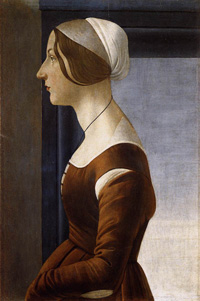
Sandro Botticelli, Portrait of a Young Woman,c. 1475, tempera on panel, 61 x 40 cm, Galleria Palatina (Palazzo Pitti), Florence
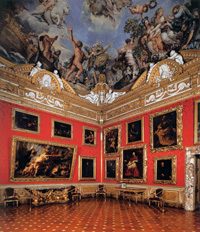
View of the Hall of Mars
|
Museo degli Argenti
The rooms on the ground floor of Palazzo Pitti, originally the grand ducal summer apartments, and the mezzanine rooms were chosen in 1861 as the location of the Silver Museum, which collects various kinds of precious objectsto document the sumptuous life of the princes and the collections owned by the dynasties that ruled Tuscany, with specific attention to the Medici and Lorraine families.
The core of the collection of Medici origin was originally preserved in Palazzo Medici in via Larga (now via Cavour), where Cosimo the Elder had started in the 15th century a lavish and diverse collection of precious objects, which would be later increased by his son Piero and his grandson Lorenzo the Magnificent. One of the most valuable categories comprises the vases of Lorenzo, which are extremely valuable pieces both historically and artistically.
The enrichment of the family collections in the 16th century by the Grand Duke Cosimo marks the cultural policy of the Medici, aimed at protecting artists and at directly commissioning precious objects. As a result, Florence became one of the most qualified centres in the production of the so-called "minor arts". The grand ducal workshops, strengthened by the second Grand Duke of Tuscany, Francesco, organised their independent and functional premises in the Uffizi palace under Ferdinando I de` Medici in 1588. Cutters of crystal, cameos and semiprecious stones, goldsmiths, etc. competed in displays of invention and superb technique to produce the objects that still constitute the main core of the Museum. Many of the jewels were sent as gifts to the kings and powerful families in Europe with which the Medici had formed a close network of relations.
|
Room of Giovanni da San Giovanni
|
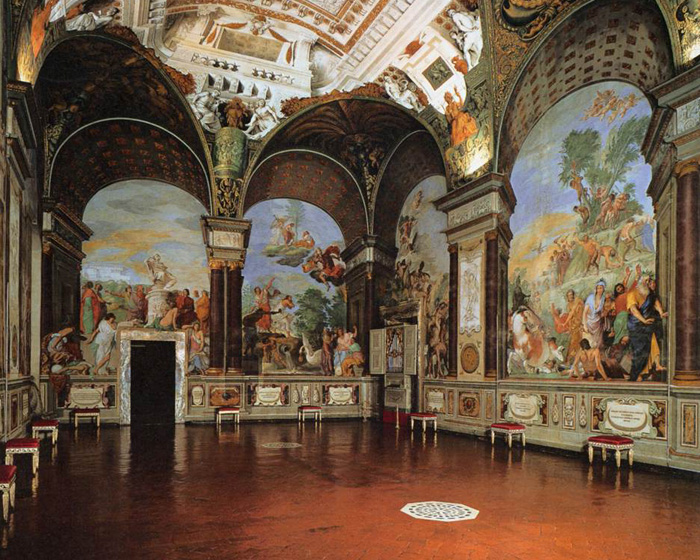 |
Room of Giovanni da San Giovanni, 1635, fresco, Galleria Palatina (Palazzo Pitti), Florence
|
One of the most refined examples is the gold-mounted lapislazuli vase by the goldsmith Bilivert, based on a design of Bernardo Buontalenti, which fully documents the preciousness of the 16th century Manneristic taste. Equally precious are the objects cut in ivory brought from Germany in the 17th century by Prince Mattias de` Medici and the large collection of cameos and the so-called "Galanterie ingioiellate" of Anna Maria Luisa, the last Medici (early 18th century), who purchased precious jewels in the whole of Europe.
Equally extraordinary are the objects brought to Florence by Ferdinando III of Lorraine after his return from exile following the brief Napoleonic period. The oldest and most beautifully worked pieces are the gold plates, beakers, "corni potori" (drinking horns) and wooden cups mounted in silver and enamel.
The present arrangement of the museum aims at focusing both on the different aspects of the grand ducal collection and on the beauty of the rooms chosen to display it, which significantly underline some of the aspects of the Florentine artistic culture. These include the great room frescoed by Giovanni da San Giovanni (1592-1636) and his assistants on the occasion of the marriage of Ferdinando II de` Medici and Vittoria della Rovere (1634), where sumptuous mythological allegories and references highlight the many aspects of the cultural and political life of the Medici under Lorenzo the Magnificent.
Art in Tuscany | Giovanni da San Giovanni (Giovanni Mannozzi) |
|
|
|
| |
|
| |
|
|
|
|
|
|
| |
|
| |
|
|
|
|
|
|
| |
|
| |
|
|
|
|
|
|
| |
|
| |
|
|
|
|
|
|
| |
|
| |
|
|
|
|
|
The Vasari Corridor
|
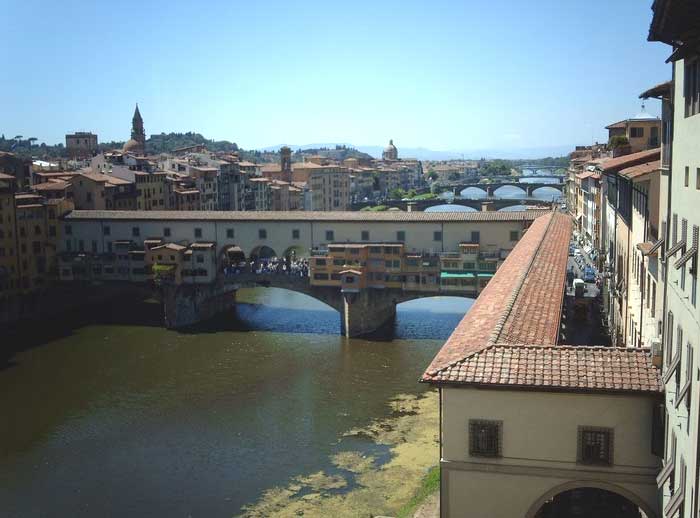 |
|
| The Vasari Corridor is a kilometer long passageway that connects the Uffizi Gallery to the Pitti Palace. Today, the corridor still connects the two buildings but it is set up as a small museum separate from the famous Uffizi Gallery.
The entrance to the Corridor is located on the first floor within the Uffizi Gallery behind an unmarked door. It is likely that most visitors that crowd the Uffizi everyday don't even know that behind that featureless door stands a great treasure.
The Vasari Corridor can be visited only upon reservation on a guided tour, organized by associations, agencies or workers of the Museum itself. The idea of entering an inaccessible, almost mysterious place makes the visit to the Vasari Corridor thrilling and intriguing.
Once you've entered the Vasari Corridor it looks like have stepped onto another dimension since the atmosphere is quiet and silent, almost unreal and completely different from the rest of the Gallery.
Works are still displayed according to guidelines issued in 1973 by a past director of the Uffizi Gallery. The collection of artwork displayed along the Corridor's walls are mostly works from the 16th and 17th centuries as well as a special and unique collection of artists' self-portraits, including works from Andrea del Sarto to Chagall. The collection is one of the most complete in all Europe, first started by Cardinal Leopoldo de' Medici in the 17th century. Many paintings and self-portraits that are a part of the collection are actually not on display for lack of space along the corridor's walls.
After you've taken just a few steps into the magical atmosphere of the Corridor this atmosphere is interrupted, even if just for a few meters, as you reach the area that was heavily damaged by a terrorist attack commissioned by the Italian mafia in 1993. During the night of May 26, 1993 a car full of explosive was set off next to the Torre dei Pulci, located between via Lambertesca and via de' Georgofili, and 5 people died. Many others were injured and several houses were heavily damaged, including this section of the Uffizi Gallery and the Vasari Corridor. In the Corridor, several artworks were destroyed by the explosion. These paintings, even if hopelessly damaged, have been pieced back together and placed back on their original spot to serve as a reminder of the horrible attack.
Passing over this part of the Corridor which reminds us of this important yet sad piece of Florence's history, youre once again brought back into its magical atmosphere.
What impresses one the most of the Vasari Corridor, in addition to the magnificent works of art on display, is the elevated and privileged position that gives you the opportunity to pass through some of the most beautiful areas of Florence's city center, walking over the heads of the people below. Sometimes you feel as if you're spying on the people walking by in the streets, especially as you look down through the small round windows that look out to the Arno river and to the city center. This was actually one of the main initial purposes for the construction of the Corridor for the Medici: the possibility to move freely and safely from their home in Palazzo Pitti to Palazzo Vecchio, the seat of government, passing and observing the people below while remaining unnoticed.
The central part of the Corridor that goes over Ponte Vecchio is the most beautiful panoramic point of view. Exactly halfway over the Ponte Vecchio, Benito Mussolini in 1939 ordered the Corridor's small windows be enlarged so that he could admire the great panorama over the Arno to Ponte Santa Trinita. The windows were to be ready for Adolf Hitler's official visit to Florence: It said he was so impressed by this magnificent panorama over the Ponte Vecchio that he ordered the bridge be saved from German bombing during World War II as they began their retreat from Florence. All the other bridges in Florence were destroyed.
After you've crossed over the Arno, you have a special view of the Church of Santa Felicita. In fact, on the left as you walk toward the Pitti Palace is a large window (today covered with a grate but still permitting a view) onto the balcony that looks directly into the church. From here, the Medici attended Holy Mass from a strategical and privileged point of view.
The current tour ends next to the famous Grotto of Buontalenti inside the Boboli Gardens.
Visits are generally reserved to groups of a set number of people because of the passage's small size.
A brief history
The Corridor called Vasari after its architect, was commissioned in 1565 by Cosimo de' Medici to celebrate the wedding of his son Francesco I with Joanna of Austria. The passageway, started in March 1565, was finished in just 5 months on time for the wedding celebrated on December 16th.
Thanks to this elevated passageway the Medici made sure they could move freely and and safely between their residence in Palazzo Pitti to Palazzo Vecchio, the government's headquarters.
Vasari's project included small windows over the streets and the Arno. Up to this point, Ponte Vecchio housed butcher shops since it made it easy for the waste to be thrown into the river. Not a pleasant view... or smell! Since the Corridor was planned over these shops, all the butcher shops were ordered off Ponte Vecchio and were replaced by jewelry shops, shops that still characterize the most famous bridge in Florence.
To build the Corridor several medieval towers located along its way were quite literally crossed. All owners were forced to consent to give the space through their properties for the passageway.... all consented except for the Mannelli family that firmly opposed having the Corridor pass through his home. It seems that Cosimo appreciated the courage the family had to stand up to him and thus permitted them to withhold entrance into their home but the Corridor still needed to connect! Vasari was forced to go AROUND the obstacle - if you look closely from below, you'll see the Corridor does go around the Mannelli tower placed at the end of Ponte Vecchio where it meets Via Bardi and Via de' Guicciardini.
For at least 200 years the Vasari Corridor was used only as a passageway back and forth between the two residences. The route, even if it was just one kilometer, wasn't just done on foot - a small carriage for two passengers took the Medici and guests back and forth. It is also likely that the Corridor had several benches along the way so that it was possible to rest.
When the Lorraine family took over Tuscany and the last will of the the last Medici, Anna Maria Luisa de' Medici, took effect the Uffizi Gallery became private property. The Corridor then lost its function of an exclusive passageway.
Over the centuries some areas were also unfortunately destroyed. In particular, during the bombings of World War II, the Corridor was heavily damaged in some areas. A beautiful bathroom decorated with frescoes and marble was completely destroyed while the end of the passageway that connected Ponte Vecchio to the south bank was bombed to prevent crossing over the river. |
|
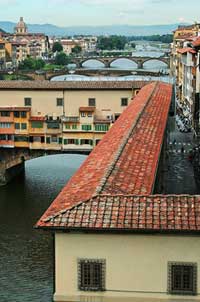
The West Corridor of the Gallery, heads towards the Arno and then, raised up by huge arches, follows the river as far as the Ponte Vecchio, which it crosses by passing on top of the shops. The meat market on the bridge was at this time trasferred elsewhere, so as not to offend the Grand Duke's sensitive nose with unpleasant smells on his walk, and replaced (from 1593) with the goldsmiths who continue to work there today. |
| |
|
|
| |
|
|
| |
|
|
| |
|
|
|
|
| |
|

[1] Kunsthistorisches Institut in Florenz | Palazzo Pitti
Address: Kunsthistorisches Institut in Florenz – Max-Planck-Institut, Via Giuseppe Giusti 44, 50121 Firenze
[2] Pietro da Corrtona (originally Pietro Berrettini), Italian painter, architect, decorator, and designer, second only to Bernini as the most versatile genius of the full Roman Baroque style. He was named after his birthplace in Tuscany and probably had some training with his father, a stonemason, before being apprenticed as a painter in Florence. In 1612 or 1613 he moved to Rome.
His first major works were frescos in Sta Bibiana, Rome (1624-26), commissioned by Urban VIII (Maffeo Barberini), and the patronage of the Barberini family played a major part in his career. For their palace he painted his most famous work, the huge ceiling fresco, Allegory of Divine Providence and Barberini Power. This was begun in 1633, but he interrupted the work in 1637 to go to Florence and paint two of four frescos commissioned by the Grand Duke of Tuscany for the Pitti Palace. He returned to finish the Barberini ceiling in 1639. This, one of the key works in the development of Baroque painting, is a triumph of illusionism, for the centre of the ceiling appears open to the sky and the figures seen from below (di sotto in su) appear to come down into the room as well as soar out of it. It demonstrates Pietro's belief, which came out in a celebrated controversy with Andrea Sacchi in the Accademia di S. Luca, that a history painting could be compared with an epic and was entitled to use many figures; Sacchi, intent on classical simplicity and unity, argued for using as few figures as possible.
In 1640-47 Pietro was back in Florence to finish his decorations in the Pitti Palace, where he received a new commission for seven ceilings. These Allegories of Virtues and Planets have elaborate stucco accompaniments uniting the painted ceilings with the framework of the rooms, and this form of decoration was widely influential, not only in Italy, but also in France. (Pietro turned down an invitation to visit Paris from Cardinal Mazarin, but his style was taken there by his best pupil, Romanelli.) From 1647 until his death Pietro again worked in Rome, his major paintings from this period being an extensive series of frescos in Sta Maria in Vallicella (the Chiesa Nuova, 1647-65), in which, as in his Pitti decorations, paint and stucco are magnificently combined. He painted many other frescoes in Rome. Throughout his career he also painted easel pictures of religious and mythological subjects.
Pietro once wrote that architecture was merely a pastime for him, but he ranks among the greatest architects of his period. His masterpiece is the church of SS. Martina e Luca in Rome (1635-50), which was the first Baroque church designed and built as a complete unity. Although his architecture has all the vigour of his painting, there is less correspondence between the two fields than might be imagined. He never decorated any of his own churches, and indeed they were not designed with fresco decoration in mind. Pietro's great contemporary reputation sank in the next century with that of many other Baroque artists. In a famous passage in his Dizionario delle belle arti (1797), Francesco Milizia wrote: 'Borromini in architecture, Bernini in sculpture, Pietro da Cortona in painting... represent a diseased taste — one that has infected a great number of artists.'
BIBLIOGRAPHY
Damien Wigny, Au coeur de Florence : Itinéraires, monuments, lectures, 1990
|

Tuscan Holiday houses | Podere Santa Pia
|
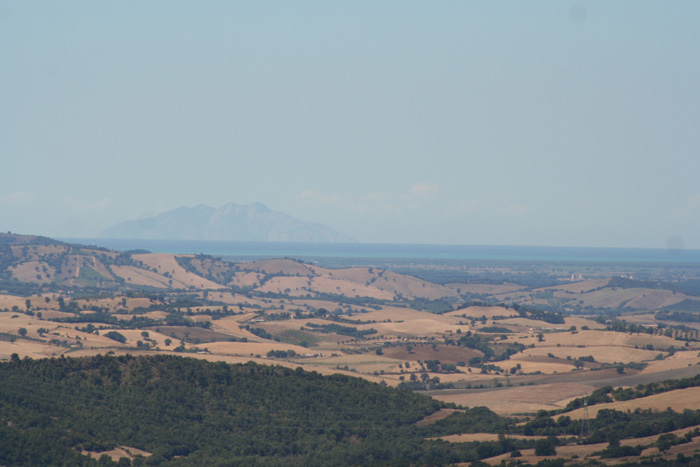 |
Podere Santa Pia, the view from the main terrace is definitely spectacular
|
| |
|
|
|
|
|
|
|
|
|
|
Podere Santa Pia |
|
Podere Santa Pia, garden |
|
Florence, Duomo
|
| |
|
|
|
|
|
|
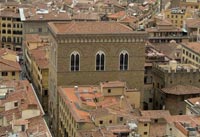 |
|
|
Montecristo, view from Santa Pia
|
|
Florence, Orsanmichele |
|
Monte Oliveto Maggiore abbey |
The House of Bianca Cappello
|
|
|
|
|
A short distance away from the Pitti Palace, in the via Maggio, can be found the house of Bianco Cappello, which still retains its beautifully decorated facade.
Bianca's house is, by far, the best example in Florence of a technique known as sgraffito, which was commonly used in the 16th century.
Bianco Cappello was a Venetian noblewoman, who became first the mistress and then the wife of the second Grand Duke of Tuscany, Francesco I de' Medici. She arrived in Florence as the young bride of an impecunious Florentine. The couple had in fact eloped, much to the dismay of her family. We don't know when exactly Bianca and Francesco met, but it was love at first sight as far as the latter was concerned. His marriage to Joanna of Austria did nothing to quell his ardour and when Bianco's husband was fortuitously stabbed to death she became his mistress.
He installed her in this palace so that she could be near to him and when his own wife died he promptly married her. Ten years later both Francesco and Bianca died within a day of each other.
The words sgraffito and sgraffiti come from the Italian word sgraffiare (”to scratch”), ultimately from the Greek γρ?φειν (gráphein), meaning “to write”.
Graffiti, the bane of all modern cities in the form of spray paint, in its original sense refers to marks scratched onto a surface with a tapered point. The graffito technique has been used since prehistoric times. Decades ago, my father showed me graffito animals, birds and people carved on the tufa cave walls in northern New Mexico. But in Florence, starting in the 1400s, it was a technique of wall design, where the top layer of pigment or colored plaster is scratched through to reveal an underlying layer.
The historian and artist Giorgio Vasari recorded the graffito technique step by step. First, one paints the wall of a palazzo with a layer of lime plaster, coloured with burnt herbs or other dark pigments. Once the first layer is dry, another is painted on, this time of white plaster, distributed uniformly. On top of this second layer are laid punched-out designs, or stencils, which are reproduced on the wall with powdered charcoal (referred to as tecnica dello spolvero in Italian). A tapered awl is then used to trace the resulting pattern on the wall, cutting through the layer of white plaster to reveal the darker, underlying layer. Thus, by using the same colours as a palazzo’s frescos, the graffito designs could be used to add shadow and depth to the overall decoration.

|
|
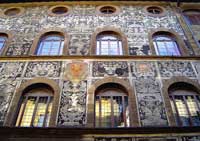
16th century sgraffito on Bianca Cappello's house |
The fortress of Belvedere, located on the hill behind the garden of Boboli, is often referred to as «the most beautiful terrace on Florence». Art exhibitions and summer festivals are held here.
History
The sixth city walls, built in the 14th Century, included a bastion at the side of the Gate of San Giorgio: on this bastion was built between 1590 and 1595 a fortress dedicated to St. Mary, but better known as «Forte di Belvedere», due to the beautiful panoramic view of the city that can be enjoied from here.
In the intention of Duke Ferdinando I de' Medici, the fortress of Belvedere should serve two purposes: along with the fortress da Basso (located near today's train station), it was conceived as a defence against invading armies - but also as a powerful instrument to keep in check the city; furthermore, the fortress of Belvedere could offer a secure refuge for the Medici family in case of an internal uprising, due to its direct connection with the Gardens of Boboli and the Pitti palace.
The fortress was designed by Bernardo Buontalenti (although Giovanni de' Medici, the Duke's brother, was the official director of the construction) and is characterized by the polygonal plan and by the small villa in the middle.
Until 1951 the Fortress of Belvedere was a military facility; in that year the Italian Army donated it to the City of Florence. After a restoration, since 1955 the fortress is open to visitors and is regularly used for modern art exhibitions as well as for festivals and open air spectacles during the summer.
This fortress is a good example for Italian military architecture from the Renaissance: it contains elements with a pure military function (as the inclined bastions), but also its propagandistic role is clear. The fortress of Belvedere was conceived as a proof of the Medici's power, as is suggested by the villa built on top of the bastions: this small building is clearly visible from the city and its shape is unmistakable in the panorama of the hills on the southern side of Florence.
Walking in Tuscany | Florence | San Niccolo Neighbourhood in Oltrarno |
|
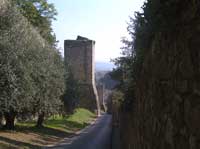
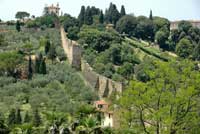
View from S. Miniato al Monte of the medieval and Renaissance fortifications that Michelangelo worked on for a year or two when the Florentine Republic was at war with the Medici supporters. Beyond, the terraces of the newly opened Bardini Gardens.
|
|
 |
|
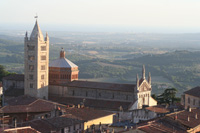 |
|
 |
Sant'Antimo, between Santa Pia and Montalcino |
|
Massa Marittima |
|
The towers of San Gimignano |
| |
|
|
|
|
| Palazzi a Firenze / Palaces in Florence | Palazzo Acciaiuoli, Palazzo Adorni Braccesi, Palazzo degli Alessandri, Palazzo dell'Antella, Palazzo Antinori, Palazzo Arcivescovile, Palazzo dell'arte dei Beccai, Palazzo dell'Arte dei Giudici e Notai, Il Bargello, Palazzo Bartolini Salimbeni, Palazzo de' Benci, Palazzo di Bianca Cappello, Palazzo Buondelmonti, Palazzo dei Canonici, Palazzo Capponi Covoni, Palazzo Cocchi-Serristori, Palazzo dei Congressi, Palazzo Corsini, Palazzo Corsini al Prato, Villa Corsini a Castello, Palazzo Da Cintoia, Palazzo della Gherardesca, Palazzo Fenzi, Palazzo dei Frescobaldi, Palazzo Galileo, Palazzo Gondi, Palazzo Lenzi (French Consulate), Palazzo Giugni, Palazzo Guadagni, Palazzina della Livia, Palazzo Malenchini-Alberti, Palazzo Medici-Riccardi, Palazzo Mellini Fossi, Palazzo della Misericordia, Palazzo della Missione, Palazzo dei Mozzi, Palazzo Nasi, Palazzo Nonfinito, Palazzo Pandolfini, Palazzo Pazzi, Villa la Petraia, Palazzo Pitti, Palazzo Portinari Salviati, Palazzo delle Poste Centrali, Palazzo Pucci, Palazzo Ramirez de Montalvo, Palazzo Ricasoli, Palazzo Rucellai, Palazzo Sacrati (Guadagni-Strozzi di Mantova), Casino Salviati, Palazzo di San Clemente, Palazzetto Serragli, Palazzo Serristori, Palazzo Spini Feroni, Palazzo Strozzi, Palazzo Taddei, Palazzo Torrigiani Del Nero, Palazzo Uguccioni, Palazzo di Valfonda, Palazzo Vecchio, Villa il Ventaglio, Palazzo dei Visacci, Palazzo Vivarelli Colonna |
This page uses material from the Wikipedia articles Palazzo Pitti, and Boboli Gardens published under the GNU Free Documentation License.
Wikimedia Commons has media related to Palazzo Pitti and Boboli Gardens.
|
|
|
| |
|
|
|
| |
|
|
|
| |
|
|
|
| |
|
|
|
| |
|
|
|
| |
|
|
|
![]()
![]()
![]()
![]()
![]()






